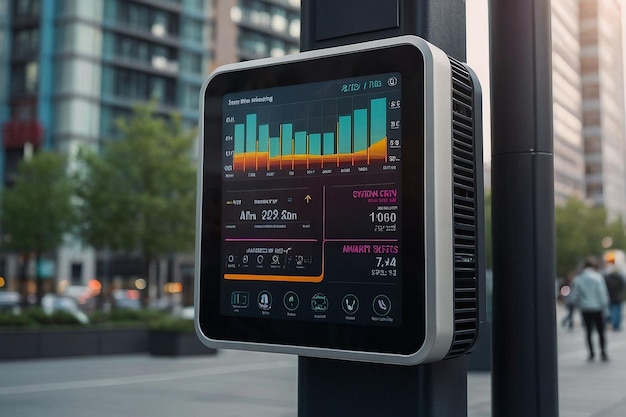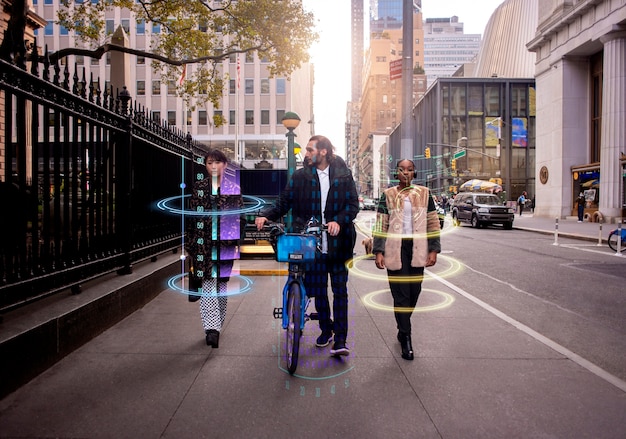Smart Cities: Revolutionizing Urban Life with Data and Connectivity

Smart cities leverage data and connectivity to enhance urban living through improved infrastructure, efficient services, and a higher quality of life for residents, fostering innovation and sustainability.
Imagine cities where traffic congestion is a thing of the past, energy is used efficiently, and public services are readily available at your fingertips. This is the promise of smart cities, where data and connectivity are transforming urban life as we know it.
Understanding the Smart City Concept
The concept of a **smart city** is more than just technological upgrades; it’s about creating a sustainable, efficient, and livable urban environment. It involves integrating technology and data to improve city services, infrastructure, and the overall quality of life for its citizens. Let’s delve into the core elements that define a smart city.
Key Elements of a Smart City
A smart city relies on several key elements working together to achieve its goals. These elements include:
- Data Collection: Gathering information from various sources like sensors, cameras, and citizen feedback.
- Connectivity: Ensuring seamless communication between devices and systems through robust networks.
- Data Analytics: Processing and analyzing collected data to identify patterns and insights.
- Smart Infrastructure: Implementing technology in physical infrastructure like transportation, energy, and waste management.
By focusing on these components, cities can gain valuable insights that lead to innovative solutions and improved services.
Ultimately, the vision of a smart city is one where technology and data are harnessed to create a better urban experience for everyone, from residents to visitors.

The Role of Data in Smart City Development
Data is the lifeblood of a **smart city**. Without data, a city cannot effectively monitor its operations, identify inefficiencies, or develop targeted solutions. In this section, we’ll explore the various ways data is collected, analyzed, and used within a smart city environment.
Data Collection Methods
Smart cities employ a diverse range of methods for collecting data. Some of the most common include:
- IoT (Internet of Things) Devices: Sensors embedded in infrastructure, vehicles, and even personal devices.
- Public Wi-Fi Networks: Gathering location data and usage patterns from connected devices.
- Citizen Reporting: Allowing residents to report issues and provide feedback through mobile apps and online platforms.
- Video Surveillance: Using cameras to monitor traffic flow, public safety, and environmental conditions.
These methods generate a wealth of information that, when processed and analyzed, can offer valuable insights into the city’s operations.
Data-driven decision-making is key to addressing urban challenges and improving the lives of residents.
Smart Transportation Systems
**Smart cities** are revolutionizing transportation through the use of data and connectivity. These advancements aim to improve traffic flow, reduce congestion, and enhance the overall commuting experience. Let’s take a closer look at some of the innovative transportation solutions being implemented.
Examples of Smart Transportation:
- Adaptive Traffic Signals: Adjusting signal timing in real-time based on traffic conditions.
- Smart Parking Systems: Providing real-time information on available parking spaces.
- Connected Vehicles: Enabling vehicles to communicate with each other and with the infrastructure.
- Public Transportation Optimization: Using data to improve bus and train routes, schedules, and frequency.
By implementing these smart transportation solutions, cities can create more efficient and sustainable transportation networks.
Investing in smart transportation infrastructure is essential for creating a more livable urban environment.

Smart Energy Management
Energy efficiency is a critical component of a **smart city**. By leveraging data and connectivity, cities can optimize their energy consumption, reduce waste, and promote sustainability. Here’s how smart energy management is transforming urban areas.
Strategies for Smart Energy Management:
Smart cities employ various strategies to manage energy consumption effectively:
- Smart Grids: Enhancing the efficiency and reliability of energy distribution through real-time monitoring and control.
- Smart Buildings: Automating energy usage in buildings based on occupancy, weather, and other factors.
- Renewable Energy Integration: Incorporating renewable energy sources like solar and wind power into the city’s energy mix.
These strategies contribute to energy savings and environmental sustainability.
Embracing smart energy management is crucial for building sustainable and resilient urban communities.
Challenges and Opportunities in Smart City Development
While the concept of a **smart city** holds immense promise, its development is not without challenges. These challenges range from technological hurdles to ethical considerations. However, overcoming these obstacles can unlock significant opportunities for urban innovation and growth. Let’s explore some of the key challenges and opportunities.
Key Challenges:
- Data Security and Privacy: Protecting sensitive data collected from citizens and infrastructure.
- Digital Divide: Ensuring equitable access to technology and internet connectivity for all residents.
- Interoperability: Establishing standards and protocols for different systems and devices to communicate seamlessly.
- Funding and Investment: Securing sufficient financial resources to support smart city initiatives.
Addressing these challenges is essential for realizing the full potential of smart cities.
By tackling these challenges head-on, cities can pave the way for a smarter, more connected future.
The Future of Smart Cities
The future of **smart cities** is filled with possibilities, driven by continuous technological advancements and a growing focus on sustainability. Expect to see even more integration of AI, machine learning, and other cutting-edge technologies in urban environments. Now, let’s discuss how we can envision the future.
Emerging Trends in Smart Cities:
- Artificial Intelligence (AI): AI-powered systems will automate tasks, optimize processes, and provide personalized services.
- Blockchain Technology: Enhancing data security and transparency in urban operations.
- 5G Connectivity: Enabling faster and more reliable communication between devices and systems.
- Sustainable Urban Development: prioritizing environmentally friendly practices and technologies.
As technology continues to evolve, smart cities will become increasingly intelligent, responsive, and sustainable.
Continuous innovation will transform urban life and create more resilient and livable communities.
| Key Element | Brief Description |
|---|---|
| 💡Data Collection | Gathering real-time data from IoT devices and citizens. |
| 🌐Connectivity | Ensuring seamless data exchange between devices. |
| 📊Data Analytics | Analyzing data to improve city services. |
| ⚡Smart Energy | Managing energy consumption for sustainability. |
Frequently Asked Questions
A smart city uses data and technology to improve urban living, including efficiency, sustainability, and citizen well-being. It integrates various digital solutions across its infrastructures and services.
Data from sensors and connected vehicles enables adaptive traffic signals, real-time parking information, and optimized public transit. This reduces congestion and improves commute times for citizens.
Key challenges include ensuring data security, addressing the digital divide, maintaining interoperability among systems, and securing adequate funding. Overcoming these hurdles is critical for success.
Through smart grids and buildings, energy consumption is optimized using real-time monitoring and automated adjustments. Integrating more renewable energy sources further enhances energy efficiency and reduces environmental impact.
Expect increased use of AI, blockchain, and 5G connectivity to automate tasks, enhance security, and enable faster communication. Sustainable development will remain a core focus, ensuring urban areas are livable.
Conclusion
In conclusion, the integration of data and connectivity is revolutionizing urban living, transforming cities into more efficient, sustainable, and livable spaces. As technology continues to advance, smart cities will offer even more innovative solutions to address urban challenges and improve the quality of life for their citizens. The journey towards smarter urban environments is an ongoing process that requires collaboration, innovation, and a commitment to creating a better future for all.





